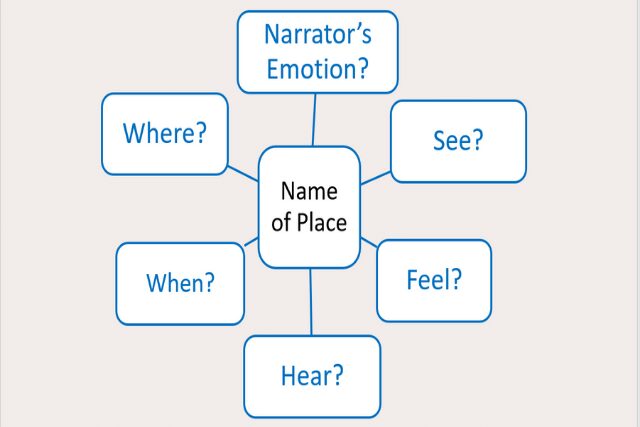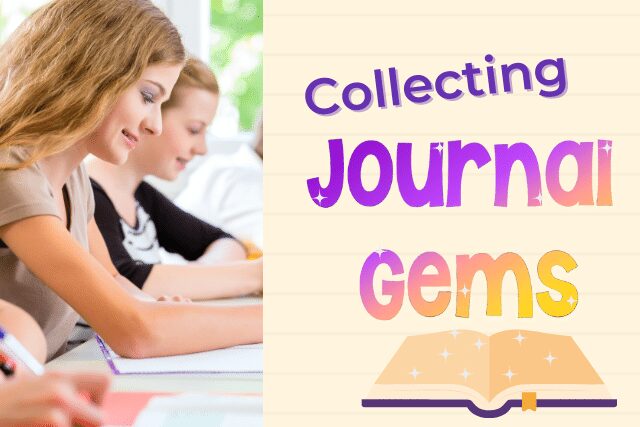Writing Journal Gems
Collecting writing journal gems or entries gives students a plethora of writing opportunities to choose from. These little gems are often hidden within the bell ringers and other quick writing/thinking activities. Journal Gems give your writers more ideas to write about.
What are Writing Journal Gems?
Journal Gems are the pieces of various writings we have started from mini-lessons and bell ringers. When student writers need ideas for longer pieces of writing, they can gather some of these together and revise these journal entries.
Some teachers call these seed ideas. However, I like calling these entries journal gems because gems are precious, and they are in raw form. For example, a jeweler cuts and polishes gems to make them sparkle and show their best facets. As writers, we have to revise and edit writing to make it sparkle and keep a reader’s attention.
What Journal Gems are not:
To clarify, not ALL entries should be considered journal gems. Some may be notes, or some might be writing experiments gone wrong. Other journal entries might include students trying out a technique, but nothing more will be done with those entries.
Journal gems are those special entries that students may want to use in future writings.
Why use writing journals in a classroom that has computers?
You might be wondering why I use journals when I have a computer lab. This school year has been bananas for me in the classroom because I have had to set up and break down 3 separate computer labs.
That’s 39-40 computers in the past five weeks. I’ve had to rearrange my desks and tables to accommodate these changes as well as my lesson plans! Because we’ve had 3 days of Internet downtime in the classroom, we had to use journals for those three days, which saved me and my writers!
There are going to be times when your students will need to be able to switch from computers to journals and back. Personally, I have experienced this computer downtime every year, at least 3-4 times a year. It happens. So, I like to be prepared for it.
I do have an earlier blog post about why I use paper/pencil journals in my classroom, which I will link here:
Writing Journals or Computers?
To find out more about using writing journals – click on my video below.
What are some journal gem activities that you can do with your students?
Listing
Lists help generate a variety of ideas. I have had students list favorite activities, places, people, things. We make all kinds of lists for a variety of activities, even reading activities.
Mind Mapping
Usually, during writing time, students choose from a bell ringer list to a mind map or draw to get more details for their writing.
We don’t always develop these right away into longer pieces of writing. So, students are collecting these gems for later. Much like professional writers do various writing exercises and mine their writing journals for gems when they need to write a blog post or a fictional scene.
Describing a Place
For example, I had students create a list of places real or imaginary as a journal entry. Then, as another journal entry, I asked them to choose ONE of those places and to create a Mind map of this place.
They used the following mind map:

Adding Sensory Details
After this, writers used my digital Sensory Word Flip Book. This is where they further mind mapped sensory details that matched the emotion they were trying to express to the reader. Here’s the link to my Digital and Printable Sensory Word Flip Book with Description activities in my Teacherspayteachers store: Sensory Details Flip Book with Writing Activities with Updated Digital Format
Then, my students wrote a descriptive paragraph from the point of view of the narrator, who is in a particular emotional state and is experiencing this place.
I explained that description through the eyes of the narrator provides mood and tone and a way for readers to empathize with that character.
Story Starters
Another way to collect journal gems is to give a writing prompt or picture prompt during your bell ringer. Ask students to use one of the 5 tricks to break writer’s block to think about this prompt. Then, on their computer, they begin this story. Give them 20 minutes to write a story starter.
Once again, they can use one or more of these later on in the year to continue their story to practice narrative writing. You could even print out these story starters for students to tape into their notebooks (for when they are searching for those journal gems).
How can students mine for these journal gems later?
Now many of my students want to write stories about the narrators and places they’ve described. When students are finished with assigned classwork, I give them choice opportunities. They can use one of the journal gems to create a piece of writing in any genre for one of these opportunities.
Later in the school year, we will be writing stories, so my writers also may want to find these journal gems and refine them in a longer piece of writing.
I could give a writing activity where students mine these gems, but my students will need some organization to be able to do that.
Organizing writing journals to make journal gems easier to find
One way you could help writers to organize their journals is to divide the writing journal into sections, like writing ideas, notes, writing techniques, etc. Use index tabs (made from sticky notes) to mark these sections.
Or your writers can keep a chronological journal like mine do with all of their notes, lists, mind maps, writing sprints, etc. Each new page has a title and date at the top. Also, I gave students space to create a table of contents at the front of their journals, so they can find these gems easier.
You can also give writers sticky notes or stickers to flag those pages that contain journal gems when they are ready for longer pieces of writing.
How I grade journal entries:
You may be wondering if I grade my journal entries. I do – I group several journal entries together and then create that assignment inside my school’s Canvas Learning Management System. Then, I assess those journal entries in the class, using a rubric.
For students who are quarantined at home, I tell them to take pictures of those pages and upload them to Canvas.
The writers in the classroom meet with me for short writing conferences, and I assign the grade then. They are worth 100 points each, and I am looking for them to meet the following criteria:
| Criteria | 25 points | 13 points | 7 points | 0 points | Criteria worth |
| All journal entries included for the weeks assigned. | Includes all assignments | Includes some journal entries | Many journal entries are missing, but a few exist | No journal entries were attempted for this time period. | 25 points |
| Titles of all journal entries and dates are included at the top of the page | All journal entries contain correct titles and dates. | Some journal entries contain correct titles and dates. | Few journal entries contain correct titles and dates. | No journal entries contain correct titles and dates. | 25 points |
| All journal entries assigned are complete and directions were followed. | All journal entries are complete and directions were followed. | Some journal entries are complete and directions were followed. | Few journal entries are complete and directions were followed. | No journal entries are complete and directions were followed. | 25 points |
| Journal writes reflect the skills, strategies, and techniques learned in class for this time period. | Most journal entries reflect the skills, strategies, and techniques learned in class for this time period. | Some journal entries reflect the skills, strategies, and techniques learned in class for this time period. | Few journal entries reflect the skills, strategies, and techniques learned in class for this time period. | No journal entries reflect the skills, strategies, and techniques learned in class for this time period. | 25 points |
| Total points | 100 points |
Final Thoughts about Collecting Journal Gems
Collecting journal gems throughout the school year allows students to choose from a rich variety of ideas they have created. Some journal gems may be suited more for poetry, some for essay writing and others for story writing or scripts.
Whatever the genre may be, students will have a wonderful collection of raw material to choose from as they mine for their gems to refine and combine them into a well-written piece of writing.
One of the things that really helped my students create journal gems is the 5 Tricks that Break Writer’s Block, click on the form below:

